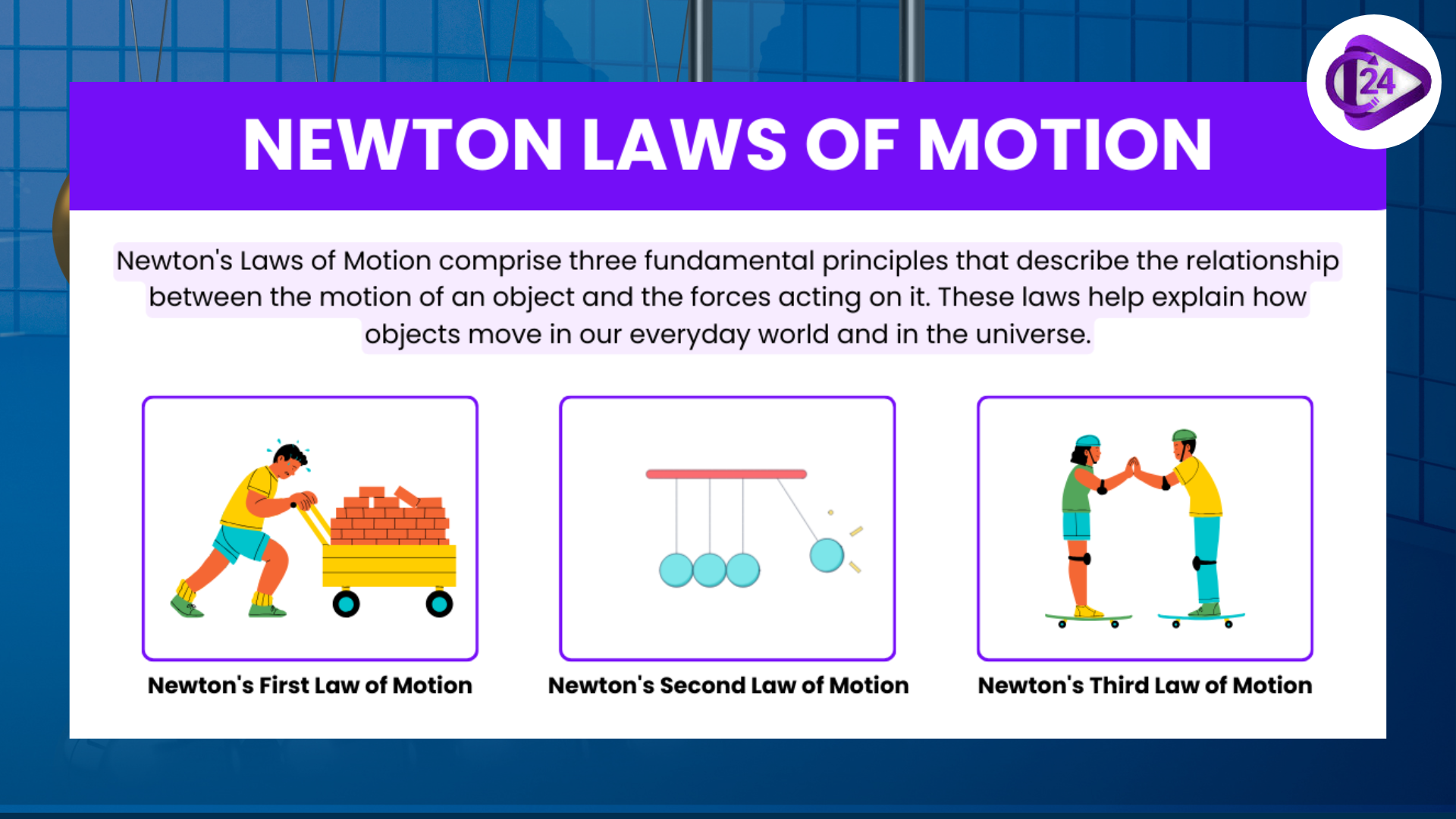Newton’s Laws of Motion: The Foundation of Classical Physics

Each time you push a door, ride a bike or drop your phone, you are feeling the same principles that are used to determine how planets circle the sun. These are the laws of motion of Newton, which explains the correlation between the movement of an object and the forces applied to it.
Initially formulated by Sir Isaac Newton in his masterpiece Philosophiæ Naturalis Principia Mathematica (commonly abbreviated as The Principia) in 1687, the laws form the foundation of classical mechanics, the branch of physics that describes the movement and the reasons of why things move. The laws set forth by Newton are still needed in science as well as in engineering and in our day-to-day lives, centuries later.
Newton’s First Law of Motion: The Law of Inertia
This is also known as the Law of Inertia. Inertia refers to an object’s tendency to resist changes in its state of motion. Simply put, things don’t start moving, stop moving, or change direction on their own - there must be a force acting on them.
Breaking it Down
When you put a book on a table it is not going to move unless you push it. That’s inertia at work. After pushing it to an extent, the force (friction) will come into play and prevent it to slide indefinitely.
Objects move due to a straight line in the outer space where there is almost no friction and air resistance. This is why the satellites go round the earth and why the astronauts in space appear to be floating - there is no one to slow them.
Real-Life Examples of the First Law
- Seatbelts in cars: When a car stops suddenly, your body wants to keep moving forward because of inertia. Seatbelts apply the external force needed to stop you safely.
- Kicking a soccer ball: The ball won’t move until you apply force with your foot. Once in motion, it will keep rolling until friction or another object (like the goalpost) stops it.
- Tablecloth trick: When a magician yanks a tablecloth from under dishes, the dishes stay put - that’s inertia resisting the sudden motion.
Why It Matters
Newton’s First Law explains stability and motion in everything from vehicle design to spacecraft navigation. Engineers consider inertia when building vehicles, ensuring they can accelerate and decelerate safely. It also helps scientists understand why planets and comets keep moving through space without constant propulsion.
Newton’s Second Law of Motion: The Law of Force and Acceleration
This law can be expressed with the famous equation
F = m × a
Where:
- F = Force (measured in newtons)
- m = Mass (measured in kilograms)
- a = Acceleration (measured in meters per second squared)
What It Means
The second law describes how the motion of an object changes when a force is applied. The greater the force, the greater the acceleration - but the greater the mass, the smaller the acceleration for the same amount of force.
For example, pushing an empty shopping cart is easy, but pushing a full one requires more effort. The full cart has more mass, so it accelerates less under the same push.
In essence, this law tells us how much motion a force produces.
Real-Life Examples of the Second Law
- Car acceleration: When you press the gas pedal, the engine applies force to the wheels, causing the car to accelerate. The heavier the car (or the more passengers it carries), the more force is required to achieve the same acceleration.
- Throwing a ball: A stronger throw applies more force, giving the ball higher acceleration and speed.
- Rocket launches: Rockets demonstrate Newton’s Second Law on a grand scale. Their engines produce massive thrust (force) to overcome the rocket’s huge mass and the pull of gravity.
Applications in Engineering and Science
The Second Law is vital in designing machines, vehicles, and tools. Engineers use F = m × a to calculate how much power or thrust is needed to move objects efficiently. It’s also fundamental in robotics, biomechanics, and even sports science - helping athletes understand how to generate more force and speed.
A Deeper Look: Net Force
Newton’s Second Law focuses on net force, meaning the total force after all opposing forces are considered. For example, if two people push a box in opposite directions with equal strength, the net force is zero, and the box doesn’t move. Motion only occurs when one force overcomes the others.
Newton’s Third Law of Motion: The Law of Action and Reaction
This law is perhaps the most famous of the three - and the easiest to visualize. It explains how forces work in pairs. Whenever one object exerts a force on another, the second object exerts an equal and opposite force back.
Understanding the Concept
If you push against a wall, it pushes back with equal force. You can’t see it move because the wall is attached to the ground and has much greater mass than you do. But the opposing force is still there.
In every interaction, forces come in pairs - one is the action, and the other is the reaction. These forces are equal in strength but act in opposite directions.
Real-Life Examples of the Third Law
- Walking: When you walk, your foot pushes backward on the ground. The ground pushes forward with equal force, propelling you ahead.
- Jumping off a boat: As you leap forward, the boat moves backward slightly. That’s the reaction force.
- Rocket propulsion: Rockets move upward because they expel exhaust gases downward at high speed. The downward action force creates an upward reaction force that lifts the rocket.
- Bird flight: When a bird flaps its wings, it pushes air downward. The air pushes back upward, allowing the bird to rise.
Why It Matters
Newton’s Third Law is the foundation of propulsion - the science of making things move by pushing something else in the opposite direction. From airplanes to jet skis to rockets, this principle is at the heart of all modern transportation and aerospace engineering.
It also explains many natural phenomena. Fish swim by pushing water backward; swimmers propel themselves forward the same way. Even the recoil of a gun follows the Third Law - when the bullet is fired forward, the gun moves backward.
Bringing the Laws Together
While each of Newton’s Laws explains a different aspect of motion, they’re interconnected.
Imagine throwing a ball:
- The First Law explains that the ball will keep moving unless friction or gravity stops it.
- The Second Law tells us how much the ball accelerates based on the force of your throw and its mass.
- The Third Law reminds us that as you throw the ball forward, your hand feels an equal and opposite reaction force backward
Together, they form a complete picture of motion, applicable to everything from falling apples to orbiting satellites.
Beyond Earth: Newton’s Laws in Space
One of the most fascinating things about Newton’s Laws is that they apply everywhere - not just on Earth. Space travel depends entirely on them.
- Satellites stay in orbit due to the balance of gravitational force and inertia (First Law).
- Rocket launches rely on powerful engines generating thrust (Third Law).
- Course corrections in spacecraft are calculated using F = m × a (Second Law) to determine how much force is needed to change speed or direction.
Even centuries later, space agencies like NASA still base much of their calculations on Newtonian mechanics before applying more advanced theories like Einstein’s relativity.
Common Misconceptions
It is a common notion that a continuous force is needed to create the motion. The first law of Newton rectifies this - motion does not cease unless acted upon. The other misconception is the fact that action and reaction are equalizing. They do not, but instead they move on other objects, and that is why there is still motion.
Newton’s Legacy
Isaac Newton did not only unveil three laws, but revolutionised the way that mankind perceived the universe. Prior to him, the explanation of motion used to be vague philosophically. Newton introduced math and logic into the equation, and a system was formed which could predict the movement of any object be it a bullet or a planet.
His laws are still fundamental in the field of engineering, physics and technology in the day to day life. The world around us can still be very well described using the principles of Newton despite modern theories such as quantum mechanics and relativity even in most practical applications.
Conclusion
Motion has three laws and a combination of these laws demonstrates how forces bring about movement:
First Law (Inertia): Objects do not change in their motion unless they are acted upon by some external force.
Second Law (Force and Acceleration):(F = m × a).
Third Law (Action and Reaction): There is an equal reaction to every action.
These laws are applicable to all the objects in the physical universe - the smallest particle and the largest planet. They are so bare, strong and eternal. When you are driving a car, or throwing a rocket or even dropping your keys, you are living evidence that the Laws of Motion of Newton always act.




